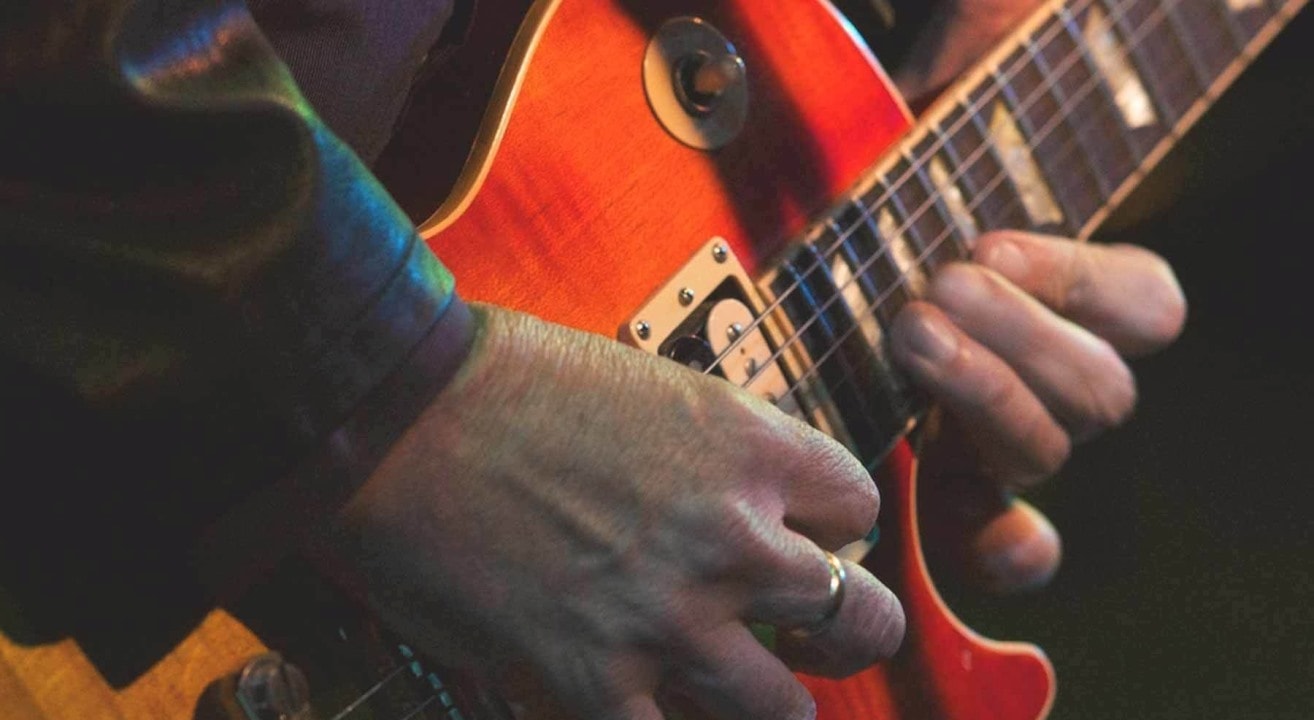Ever tried playing an electric guitar without a guitar amp? Seems like an odd question, right? We usually picture an electric guitarist shredding away, surrounded by massive amps. But life isn’t always stage-ready. Sometimes, you can’t have an amp by your side, and yet, the music must go on.
This piece is all about those moments. We’ll delve into the diverse world of amp-less electric guitar playing. We’ll explore how you can adapt to different situations, from silent practice sessions to traveling with your guitar.
Ready to rock out in a whole new way? Let’s dive into this unplugged adventure and explore the exciting alternatives to your trusty amp!
Table of Contents
Alternatives to Amplified Playing

An amplifier, or amp, as we lovingly call it, is the “electric” in the electric guitar setup. When you pick those strings, the amp takes those tiny electrical signals and turns them into a rocking tune that can fill the room. Without an amp, your electric guitar would be about as loud as a whisper.
Now, you may be wondering, “What if I can’t always have my amp around?” Don’t worry, if you can’t play through an amp, there are other options like headphone amps, software amps, or direct recording on your computer.
These are great alternatives when cranking up a traditional amp isn’t impossible. There’s even, here’s a big shock, just playing with no amplification, which holds many advantages that you might not be aware of.
Keep on Playing, No Matter Where or When
Imagine being on vacation with your guitar but no amp. Or in a thin-walled apartment late at night, melody buzzing in your head, but unable to blast it out. Maybe your living space is just too small for a big amp.
In these situations, you adapt. Traveling with an amp isn’t always practical. Late-night creativity sessions need to be quiet. And small spaces demand compact solutions.
But remember, no amp doesn’t mean that there is no music. For traveling, there are portable solutions like pocket-sized amp plugs. For quiet practice, you can use headphone amps or software amps. And if space is an issue, consider modeling amps or even the equipment you might already have.
Your Smartphone – The Amp in Your Hand!
Yep, that little thing you use throughout your day can also be your personal, pocket-sized amp.
You might wonder, “How on earth do I do that?” Well, you need a few things. First up, a guitar interface, which is a little box that lets your guitar signal travel to your device. These range in price, yet a good starter point is the Behringer Guitar Link UCG102.

We also have the TC-Helicon GO GUITAR PRO a little further up the food chain. This has a higher bit rate to offer better quality and reduced lag.
Now comes the fun part – picking your amp app. For Android users, Deplike and Tonebridge are two excellent options. Deplike offers a wide range of amp and pedal simulations, so you can tweak your tone to your heart’s content. Tonebridge is perfect for the cover artist in you, offering over 9000 preset guitar tones based on popular songs.
For iOS devices, you’ve got IK Multimedia AmpliTube and BIAS FX 2 to play with. AmpliTube is a guitar and bass tone studio that offers a massive collection of virtual gear. BIAS FX 2 is a smorgasbord of dream rigs with tons of amps, effects, and more.
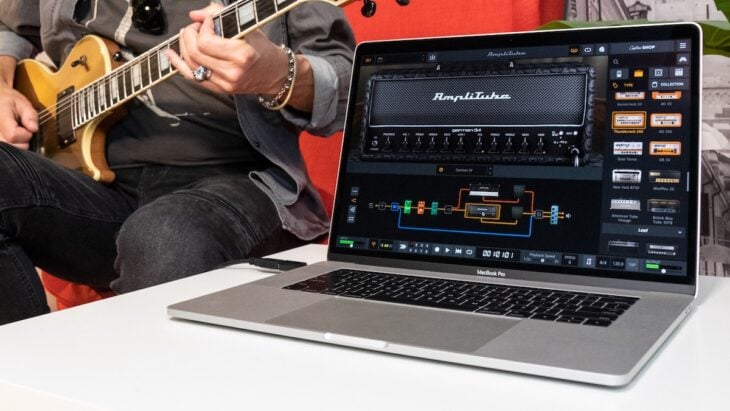
Silent Running with Modeling Devices & Headphones
There are limitations to using your phone as a modeling device. Storage for apps, constant requests to purchase an increasing number of plugins, lower sound quality, and potential for lag. Why not check out modeling devices – these slick pieces of tech can simulate the sound of different amps, effects, and sometimes even different guitars, right in your headphones.
Now, what’s so cool about these modeling devices? Well, they give you the freedom to experiment with various sounds without waking the neighbors or breaking the bank on many amps and effects pedals. Plus, you can practice anytime and anywhere.
There are several great modeling devices out there. Let’s name-drop a few favorites. Line 6’s Pocket POD, for instance, is a compact device that comes preloaded with 300 presets, including 32 classic amp models, 16 cabinet models, and loads of effects.
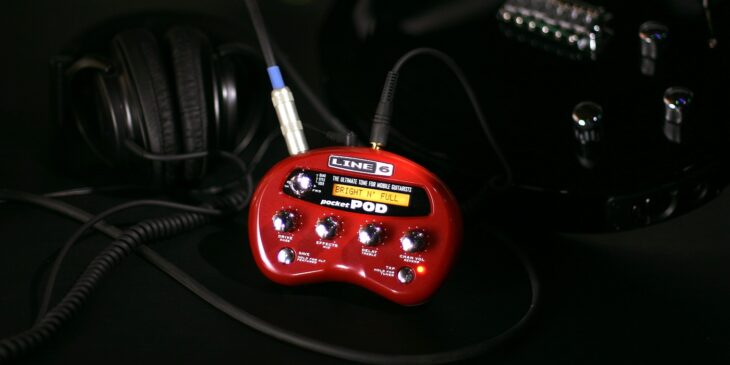
Then there’s the Boss Pocket GT Pocket Effects Processor based on their more sizable (and pricey) GT100 multi-effects pedal unit.
Then you’ve got a range of micro headphone amps from an array of famous names including Vox, Fender & Blackstar. These headphone amplifiers offer a single tone in a tiny headphone amp that plugs straight into your guitar. There’s even a headphone amplifier that makes you sound like Brian May!!
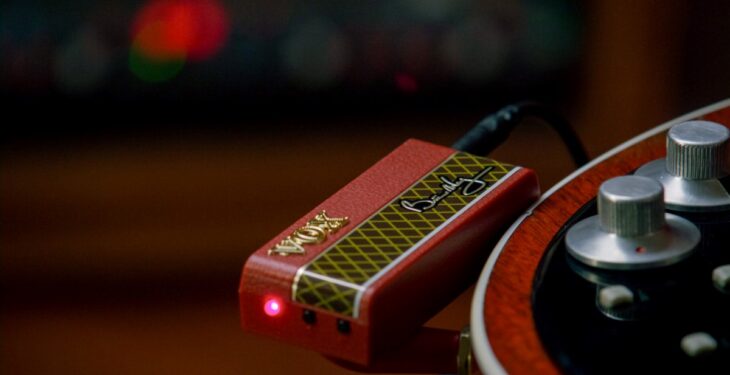
With such budget-conscious pricing, you could buy a few and just swap over whenever you like. They’re tiny enough that carrying 3 or 4 of these in your gig bag is an easy decision!
Understanding Software Amp Simulation
Software amp simulation is a digital audio workstation that replicates the sound and behavior of guitar amps, effects pedals, and sometimes even studio effects. These virtual rigs let you tweak and combine gear in ways that would be impossible or super expensive in the real world.
The benefits of these virtual wonderlands are plenty. You can experiment with a variety of sounds without splashing out on expensive physical gear. Plus, they’re perfect for late-night jam sessions or when you’re on the road and can’t lug your amp around.
One drawback is the learning curve. These programs are complex, with all their options and settings. Also, while technology has come a long way, some guitarists argue that software just can’t emulate the nuanced tones of physical amps and effects.
Still, there are several great software amp simulations to check out. Native Instruments’ Guitar Rig is a popular option with tons of amps, effects, and even microphone setups to play with. IK Multimedia’s AmpliTube and Positive Grid’s BIAS FX are also great choices, offering a vast range of gear simulations and intuitive interfaces.

A cautionary tale. I began with simple beginnings, but after 5 years of playing, I grabbed a Korg A3 multi-effects unit. This gave me a vast range of effects to process my guitar through. For a few years, I never heard my guitar without passing it through at least 4-6 effects. I came to realize that my tone was lost in all that. Funny, it was a PigNose amp that rescued me and saw me selling this unit to simplify my sound again.
The Charm of Playing Electric Guitar Unplugged
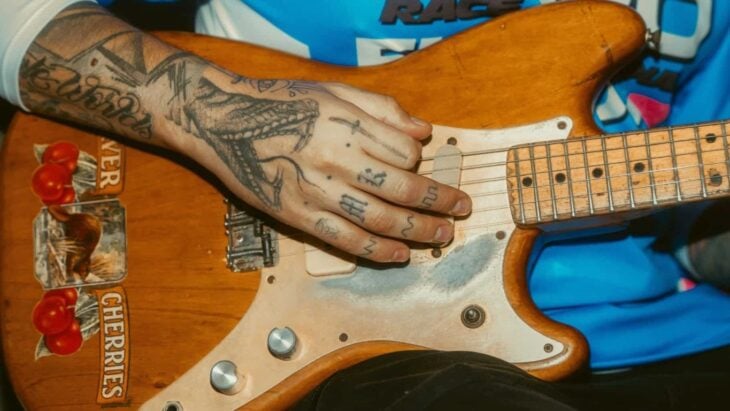
It was that period of overindulgence that helped me re-discover the delights of playing my guitar naked. No, not like that (though that happens sometimes!) I’m referring to the times when you just grab an unplugged electric guitar, sit back, and noodle. No amps, no emulators, nothing.
There is a vast amount to be gained this way. First, you don’t try to impress yourself. Second, you don’t waste time fiddling with options. You pick up, you play. I have written most of my material this way and love the spontaneity of doing this.
It is also the very best way to practice techniques. A few years ago, a former band member had a stroke following heart replacement surgery and asked how to retrain his left hand. My answer got me heading back to my basics once again.
String skipping exercises. No right hand at all. Rest your fingers on a set of 4 frets that are comfortable for your hand size. All fingers on the low E. Say 5, 6, 7, 8. Now, move 6 and 8 to the A string. Next, you move 5 and 7 to the D string and so on until your fingers are 5-8 on the high E string. Backward, forward, backward, forward. You can do this whilst you watch TV and it is best without amplification.
It’s not just practice either. You learn about the genuine tone of your instrument by playing unplugged. My super strat option (Hamer Centaura) has a well-balanced, yet dry, tone that suits its needs as an amplified beast. Yet my twin cutaway choice (PRS SE Paul’s) sings out with a ton of natural sustain. Knowing your instruments intimately is the key to getting the best out of them once you plug them in.
Expression Without Noise
Having examined mobile apps, desktop software, modeling amps, headphone amps, and even unplugged playing, we can see amps are not the only way to express your music.
Remember that playing unplugged can open a new world of intimacy with your guitar. Exploring different techniques, understanding your guitar’s natural tone, and even writing music can all be done without an amp. This versatility, adaptability, and willingness to explore are what define a guitarist.
Think about why you will need to play without an amp, then make a relevant choice that will support what you are trying to do. For me, I will always find myself back unplugged. It helps me isolate the “me” in the mix and gives me an advantage once things get rowdy again.
So, whether you’re plugged in or not, never stop making music!

